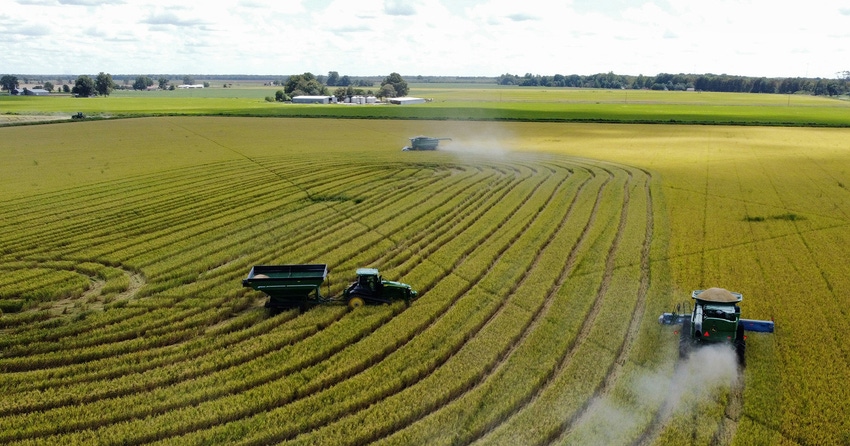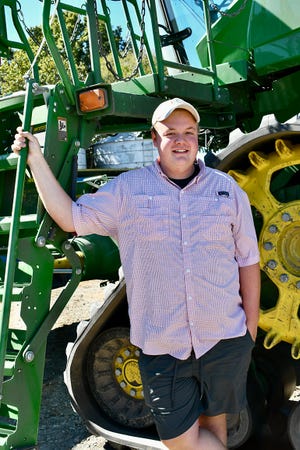
Recently, Isbell Farms in England, Ark., shared a video on Twitter and Facebook that collectively gained nearly 3,000 views. The fast-paced video features producer Mark Isbell as he shares the farm family philosophy behind their rice harvesting technique.
What is so distinctive about their rice harvest? The combines and grain carts on Isbell Farms move in a revolutionary direction, steered in a circular path around the field.
Harrison Jones is a 5th generation farmer at Isbell Farms. He grew up on the farm, where he has worked since his teen years. The family's harvest strategy was established long before Jones was even born.
“It is almost like a tradition. We have always cut in a circle, and it works great for us,” he said.
Jones shared about rice production on the family farm and leaned deeper insight into his Uncle Mark’s fast-paced social media video.
Isbell Farms implements zero-grade technology on 100% of the farm acreage. Rice is the sole crop on all 3,500 acres of the precision leveled fields.
“Our family started precision leveling land in 1977 and had most of the land leveled by the late 1980s. As new land was acquired, it was leveled. The last large scale leveling project was completed around 2003,” he said.
 Harrison Jones stands beside a John Deere combine. (Whitney Haigwood)
Harrison Jones stands beside a John Deere combine. (Whitney Haigwood)
Each precision leveled field is irrigated with an interior ditch, leaving no need for levees or levee gates.
“My great granddad started that way back,” he said. "As fields were leveled, they dug an interior ditch to aid in flooding and draining the fields. The whole interior of the field is connected by a ditch that creates a low point for water to enter and escape the field, depending on the desired conditions.”
The design of Isbell Farms allows for this distinctive harvest practice and contributes to the overall efficiency and sustainability of their farming operation.
Spiraling Through Harvest
The Isbell family has been cutting rice in a circular pattern since 1985. The center point of the field marks where the path will start.
“Before the days of GPS, my family would go out and measure from one end of the field to the other to find the center," Jones said. “If it was a long rectangular field, they would find two points to make an oval in the center. The center of each field was flagged with a piece of PVC pipe on a steel post to mark the starting point.”
Today, GPS technology easily maps the center of the field.
The combines move in a circular path around this center point until they reach the field edges. Then the remainder of the crop is harvested from the true corners of the field.
Two combines commonly run together during harvest.
“We like to have them close together, with one right behind the other,” Jones said.
During the growing season, the zero-grade technology contributes to 30% water reduction for rice irrigation. (Harrison Jones)
Each combine sets the same speed, and they record the GPS line. Within a couple of rounds, everything is set as the two commands communicate to each other through GPS technology.
Jones said this method increases productivity for both the combines and the drivers.
“The entire time that it takes to get to the field edge, the combines are going the same speed," he said. "They keep their headers in the rice the entire time. They never stop cutting. It’s maximum efficiency until they reach the corners.”
The grain cart drivers also benefit from this harvest strategy. Once the combines settle in, it is easy for the two grain carts to catch the combines in the field.
“The first grain cart driver comes in and catches the back combine," he said. "That one is full first. He then pulls up and dumps the front combine. While the first driver offloads, the second cart repeats the process.
“We dump on the go. The combine driver puts the auger out, and the grain cart driver matches the speed," he said. "Nobody ever stops. No one is ever waiting because they are full. It is a seamless operation with superior efficiency.”
Jones added that cutting in a circle is also good for the variety of wildlife living in the field. Circling through the field during harvest allows the animals a chance to retreat from the moving farm machinery.
“The theory is that you are pushing wildlife as you move through the field," he said. "When you cut in a circle, you are running them to the outside edges of the field. They are able to get into the ditch or get onto the levees to get away. It minimizes harm to all different sorts of wildlife that might be living out there.”
Even their method of cutting the corners helps to work wildlife out of the field.
“When you get to the edge of field or when you finish out the corners, you see a lot of critters running out. So, that is pretty good proof that it works,” he said.
Jones concluded that this method may not be suitable for everyone. Most of the fields on Isbell farms are square or rectangular with heavy clay soil profiles.
“It's specific to our area. We have a couple of neighbors who do this also, and they've been doing it for a long time as well.”
Further reduction in water usage comes from their participation in alternate wetting and drying, saving up to an additional 20% in water usage. (Harrison Jones)
Jones laughed as he quoted a conversation he had with his dad, Jeremy Jones.
“We may not be able to do a lot of things right, but we sure can cut rice,” the elder Jones had said.
“I can't say we necessarily influenced anybody, but we definitely created some good conversation with it,” Jones said when asked if Isbell Farms had influenced other producers to adopt this harvest practice.
Year-Round, World-Wide Sustainable Efforts
On top of harvest efficiency, Isbell Farms is also committed to sustainable year-round conservation practices.
During the growing season, the zero-grade technology contributes to 30% water reduction for rice irrigation. Nearly a decade of on-farm studies conducted by the University of Arkansas System Division of Agriculture has proven this statistic.
Further reduction in water usage comes from their participation in alternate wetting and drying (AWD), saving up to an additional 20% in water usage. Utilizing AWD also reduces methane gas emissions and lessens arsenic levels in grain.
“Through the research on our farm, we have proven that AWD reduces methane emissions by 64% as opposed to traditional irrigation methods,” Jones said.
He described irrigation on the farm. “I explain it like a bathtub. The field has an entry point and exit point for water. It fills from one point, and we can adjust the depth depending on the time of year.
“In the spring we can flush the seeds with a light coating of water to help them sprout. As the crop progresses into the growing season, we can establish a flood and add water whenever it is needed.”
The family grows traditional long grain rice. They also grow and market specialty sushi rice and Japanese sake rice. Their specific marketing and sustainably focused efforts deliver national and international attention to the family operation.
Between harvest and the happenings on Isbell Farms, they bring life to a line once penned by poet and novelist Rainer Maria Rilke.
“I live my life in widening circles that reach out across the world,” Rilke said.
That is exactly what they are doing in England, Ark.
About the Author(s)
You May Also Like






